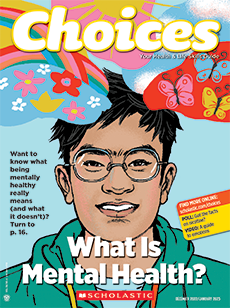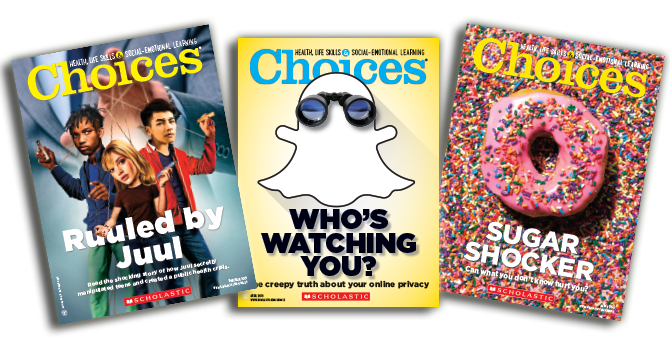Editor’s Note: In the story below, we have annotated parts of the text with key vocabulary definitions, extra information, tips, and critical thinking questions. Hover over the blue text to see the pop-up boxes! (Teachers: Please hand out our Annotated Reading Worksheet to guide students’ reading.)
Which One is #FakeNews?
Juicy headlines are creating dangerous lies online—and you’ll never believe what’s fueling the fictional madness.
A few months ago, Ibn-Husain Salaam, 15, received a devastating snap from his friend: a screenshot of an ESPN story saying that Oklahoma City Thunder point guard Russell Westbrook had suffered a career-ending injury.
“It had a picture of him crying, and I was almost crying, because he’s my favorite player,” says the high school freshman from New Jersey. “I started searching, trying to find out anything I could.”
But ESPN, where the story was allegedly from, didn’t have it. A Google search didn’t turn up any similar news either. “And that’s when I realized it was fake,” says Salaam. “I was really mad. I felt like I’d been tricked on purpose, and felt dumb for getting fooled.”
“I FELT LIKE I HAD BEEN TRICKED ON PURPOSE.”
What Salaam is describing is the nasty aftertaste of what’s come to be called “fake news”: wholly made-up information set loose on the web and spread by social networks. Now, just to be clear, this isn’t the same as scams, which are created to directly take your money (think: sites coaxing you to donate to a bogus charity). It’s not mistakes in reporting by otherwise trustworthy sources—those are usually apologized for and corrected quickly. It isn’t just facts you don’t like.
Fake news is created when someone knowingly makes up information, posts it online, and spreads it across social media, often to get quick clicks that translate into advertising earnings.
Yes, that’s right. While you squirm behind your screen—mortified by that false article you just shared with your followers—some sinister opportunists are smiling behind their laptops, thinking “cha-ching!”
ORIGIN STORY
So where did fake news come from? You probably first heard the term being used last year about phony political articles, such as one claiming that Hillary Clinton was on the brink of death (she wasn’t). But the truth is, fake news has existed for centuries.
Back in the late 1700s in France, made-up stories in newspapers called “canards” stoked the hatred of Queen Marie Antoinette (and gave us another word for “lie”). In the ramp-up to our Revolutionary War, American publishers—including Founding Father Benjamin Franklin— fanned patriotic passions by printing bogus accounts of Native American and British atrocities.
And in the late 1800s, fierce competition between newspapers led to “yellow journalism,” which used sensationalism and dubious reporting to sell papers. Oddly, truth is the newcomer: It was only at the turn of last century that The New York Times found it could carve out a niche offering readers news they could trust.
Now, with thousands of websites competing for readers, some unscrupulous purveyors have gone back to posting anything they think will sell, true or not. Last year, hundreds of excited locals commented on a story that actor Johnny Depp was moving to tiny Bethlehem, Pennsylvania, reported on the official-sounding KNP7 News site. (Um, no.) Another, from News 4 KTLA, claimed that some recalled cans of tuna had been found to contain human remains—before being debunked by fact-checking site Snopes.com. (Phew!)
Like a turn-of-the-century tabloid reader, you once again have to be extremely skeptical and savvy to tell true from false. And the forces you’re up against these days are strong.
MONEY MATTERS
Last year, Canadian teen Yaman Abuibaid, 17, told Buzzfeed News that it was Kim Kardashian who woke him to the possibilities of fake news. It began, he told the site, when his friends were spreading a piece of gossip about her at school: “I said, ‘That’s definitely fake—why would you ever believe that?’” he recounted. “And they said, 'It’s online, it’s true.' And you realize that people believe a lot of things online.”
Abuibaid and his friend Daré Adebanjo turned that knowledge into Hot Global News, a take-off on Canada’s mainstream Global News site. They mostly peddled completely false news stories about Canadian Prime Minister Justin Trudeau. The site’s “About” page labeled it satire, but those passing around its stories didn’t always see the disclaimer. Enough people shared and clicked on its headlines that the teens made tens of thousands of dollars selling advertising on the site.
Such windfalls are rarely a surprise. Just as in yellow journalism days, profits are the prime motivator of fake news. Google allows websites to make money by hosting ads, and the more clicks the sites get, the more their owners make. Hoaxers do everything they can—from carefully crafting headlines that shock you to using bots that mess with Facebook algorithms—to make their stories go viral, which helps them rake in serious dough.
Case in point: One 23-year-old whose fake news stories spread wildly during last year’s election estimated that his most popular tall tale netted him over $5,000— for just 15 minutes of work.
Health News: THE NEXT FAKE-OUT FRONTIER?
After the American media discovered that teens in Macedonia (a country in southeastern Europe) were pumping out false American political news, those same teens said that they expected their next big moneymaking market to be health articles. And it makes sense: Fake news thrives when it gives us an emotional rush, and headlines touting quick cures or deadly risks are as exciting as they come. Not surprisingly, doctors and health educators are incredibly concerned. “Research shows teens change behavior according to what they find online,” says Elizabeth Wood, of the girls’ health organization Below Your Belt. The best advice: Verify health news with trusted sources, and always ask your doc before making any big changes to your health routine.
FALLING FOR FAKES
So if we now know fake news is out there, why are we still getting duped? Reggie Fils-Aime, 13, has pondered this himself. The North Carolina seventh-grader was cautious when a friend told him that strange carvings had been discovered on the moon. “We both love science, and he really wanted to believe this article,” says Fils-Aime. “But I said, ‘Are you sure? Let’s look it up.’”
The wishful thinking that Reggie sensed in his friend is related to something called confirmation bias: We’re much more likely to buy into new information that backs up beliefs or theories we already have—while ignoring evidence to the contrary. Experts say this psychological tendency is one of the factors behind our ability to click on and believe totally bogus stories, even if the sources might register as somewhat sketchy.
So whether you’ve always had a hunch that there’s extraterrestrial life or you prefer one political candidate over another, your opinions and beliefs make you vulnerable to believing certain fictions—and the cost can be higher than simply feeling embarrassed by your inability to sniff them out.
Research on fake news shows that even after we learn a particular piece of information is fake, the emotions it gave us remain. So if you learn that a story about a certain politician’s drunk driving arrest was absolutely false, for example, you’re likely to still be left with the feeling that you just don’t trust the guy. And that gut reaction will kick in every time you hear his name afterward.
FIGHTING BACK
In the past few months, both Facebook and Google have announced programs to block fake news. Smart programmers, including some teens, have also taken up the cause, creating a handful of apps and programs that try to filter out fakes.
Stanford University freshman Karan Singhal, for example, built a website and Google Chrome extension called Fake News Detector AI, which basically looks “under the hood” of a website (checking out layout, popularity, writing style, the frequency of telling keywords, and whether it is on a well-known blacklist, among other things) to identify fakes.
Ultimately, though, experts warn that the responsibility falls on all of us. “We can’t just count on someone developing the perfect bot to identify fake news,” says Peter Adams, a vice president at the News Literacy Project, a nonprofit that’s been teaching teens to vet the news for the past decade. “There are so many people out there trying to fool you, with so many tools. You have to learn to spot it for yourself.”
You see a story online that immediately makes your heart race—but is it real? Slick design is no giveaway. Instead, look out for these signs it’s a fake:
URL: It’s a close-but-no-banana copy of a well-known site, like NBCNews.com.co instead of NBCNews.com, or it has an unusual ending, like “lo” or “su”.
Vet it: Put the legit organization’s name into Google and compare URLs, or check a suspicious URL on a trusted fact-checking site like Snopes.com or Factcheck.org.
“ABOUT US” SECTION: Most trusted sites will state clearly who’s behind them and how to get in contact. So if there isn’t one—or a site makes you register to get that info—it’s a red flag. You should also watch out for any site that says it is humor, satire, or fantasy.
HEADLINE: It’s an OMG-worthy gut punch that you desperately want to be true or untrue.
Vet it: Search the headline in another tab. If it’s true, there should be other credible outlets reporting the news. If not, add the word “hoax” to your search. Anything come up?
STORY TEXT: It includes ALL CAPS, has obvious spelling or grammatical errors, and doesn’t cite sources. (Most legit stories will say where they got their facts.)
PHOTO: There’s no credit or copyright info saying who took it and where, or it features racy, unrelated photos, like shots of women in bikinis on an alleged news site.
Vet it: Left-click it with your mouse and drop down to “Search Google for image.” If the same photo shows up on a lot of other unrelated sites and stories, chances are it was copied and repurposed here.
POP-UP ADS: You try to go to the site but get hit by a barrage of pop-up ads, one after the other. (Most reputable sites limit theirs to one or two, so as not to drive you away.)
A HISTORY OF FAKE NEWS:
IT’S ACTUALLY BEEN AROUND LONGER THAN REAL NEWS!


